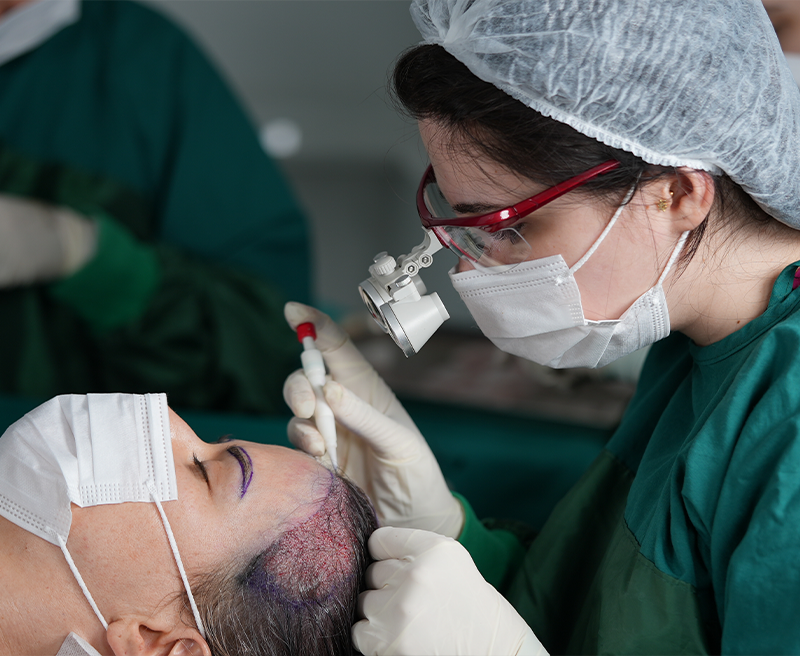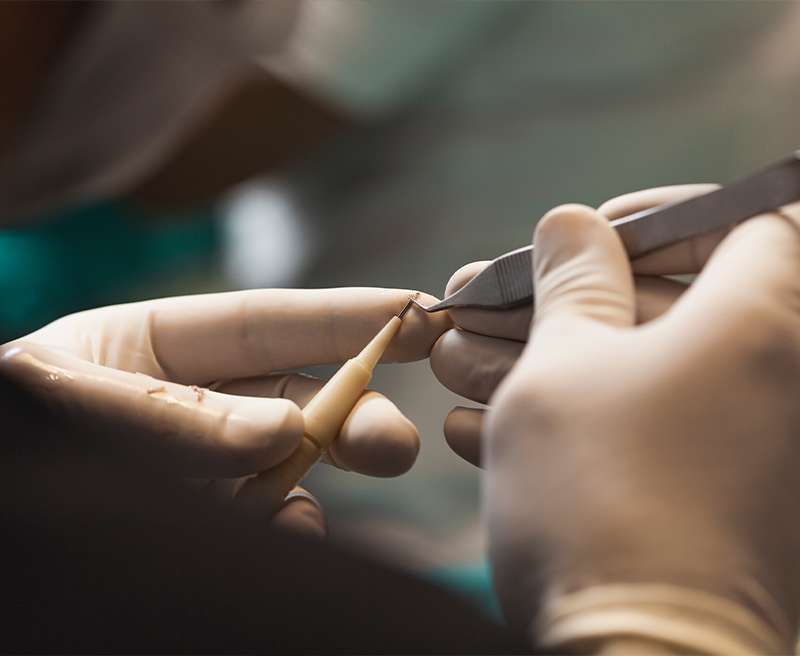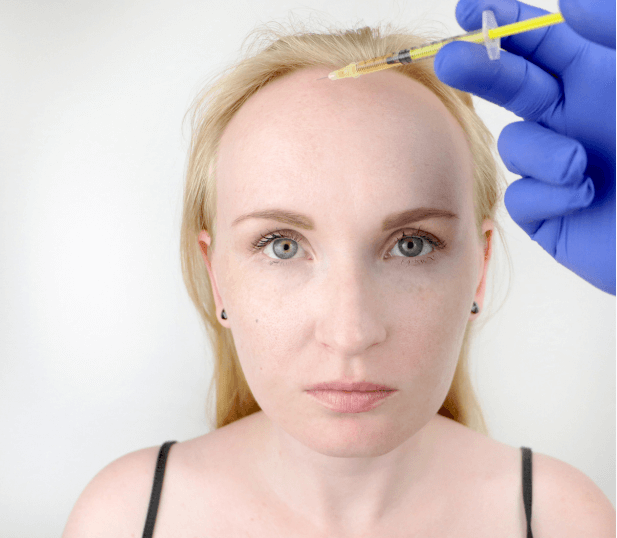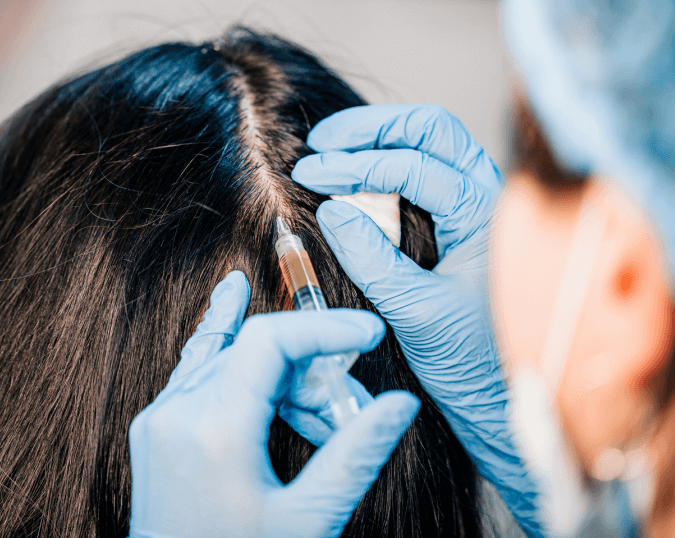HAARTRANSPLANTATION BEI FRAUEN

Aufgrund der unterschiedlichen Arten des Haarausfalls wird der Haartransplantationsprozess bei Männern und Frauen unterschiedlich gehandhabt. Dies liegt am Haarausfall Frauen können aufgrund offensichtlicherer Faktoren auftreten als bei Männern. Darüber hinaus ist die Haartransplantation bei Frauen ein eigenständiger Zweig Denn für die unterschiedlichen Ursachen des Haarausfalls bei Frauen stehen zahlreiche Behandlungsmöglichkeiten zur Verfügung. Eine Haartransplantation bei Frauen wird typischerweise zur Behandlung von Problemen wie einer Verengung der Stirn, einer Erhöhung der Haardichte und einer Reduzierung der Kopfhaut eingesetzt Kargheit. Der größte Vorteil der Haartransplantation bei Frauen besteht darin, dass sie ohne Rasur der Kopfhaut durchgeführt werden kann. Während der Bei diesem Verfahren wird im Spenderbereich ein kleines Fenster geöffnet und die Follikel werden nur an dieser bestimmten Stelle entnommen. Der Transplantationsprozess kann kann auch ohne Rasur der Kopfhaut durchgeführt werden.


How Does a Female Hair Transplant Process Work?
IWhile the core principles of hair transplantation remain the same for both men and women, the approach is often adjusted to suit the specific needs of female patients. Unlike men, women usually don’t need to shave their entire head for the procedure. Instead, only a small patch (window) of the donor area (usually at the back of the scalp) is shaved. This small area can be easily concealed with the surrounding hair, allowing women to continue their daily lives without any significant interruption.


1. Follicular Unit Extraction (FUE):
In the FUE technique, individual hair follicles are extracted from the donor area using a micro-punch tool. These follicles are then carefully implanted into the recipient area, one by one. The FUE method is minimally invasive, leaving no linear scars and ensuring a quicker recovery. It's ideal for women looking for a less noticeable procedure since only a small patch of the donor area is shaved.
2. Direct Hair Implantation (DHI):
DHI is a more advanced technique where hair follicles are extracted and immediately implanted into the scalp using a specialized tool called a Choi pen. This allows for more precise placement and a higher survival rate of transplanted hair. DHI does not require the creation of recipient sites beforehand, which can lead to a more natural-looking hairline and density.







Is African American Hair Suitable for Female Hair Transplant?
Hauptunterschiede zwischen Haarausfall bei Männern und Frauen
Haarausfall bei Männern wird meist durch genetische Ursachen verursacht, während er bei Frauen aufgrund genetischer Faktoren oder als Folge mehrerer Ursachen auftreten kann, wie z
als:
- Hormonelle Ungleichgewichte oder Störungen
- Vitaminmangel
- Eisenmangel
- Blutwertmängel
- Hormonelle Veränderungen nach der Empfängnis
Critical Considerations for Hair Transplantation in Women
If these tests reveal that hair loss is due to hormonal imbalances or deficiencies, hormone therapy should be initiated, and hair transplantation should be postponed until after the treatment is completed. Addressing the underlying cause first is crucial to achieving the desired results. Similarly, if a vitamin deficiency is identified, it should be corrected before proceeding with the transplant to ensure optimal outcomes.
Hair transplantation in women is a highly specialized field, requiring careful consideration of individual health factors to achieve the best possible results. By addressing the root causes of hair loss and choosing the right professionals (doctor, clinic) women can regain their confidence and enjoy a fuller, healthier head of hair.
- Homogram
- Ferritin
- B12
- TSH
- T3
- T4
- FSH
- FSH
- LH
- Progesterone
- Estradiol
- Prolactin
- Testosterone
- D3 Vitamin


How long does it take for a transplanted hair to grow?
Typically, noticeable results from a hair transplant begin to appear after 3-4 months. The full effects, including significant hair growth, are usually visible between 8-12 months. During this period, your hair can grow up to 15 centimeters. The rate of hair growth after a transplant largely depends on your individual hair growth cycle and how your body responds to the procedure.
UNSERE BEHANDLUNGEN
UNSERE TECHNOLOGIEN
HAARTRANSPLANTATION BEI FRAUEN
So führen Sie eine Haartransplantation bei Frauen durchBei der Haartransplantation handelt es sich um eine Operation und Behandlung, die unabhängig vom Geschlecht bei jedem über 22 Jahren durchgeführt werden kann. In der heutigen
Weltweit ist die Haartransplantation zugänglicher geworden und mittlerweile eine gängige Lösung für Menschen, die unter Haarausfall leiden. Das wichtigste
Ein wichtiger Faktor bei diesem Prozess ist die Sicherstellung, dass die Haartransplantation von erfahrenen Fachleuten durchgeführt wird. Ansonsten sind die gewünschten Ergebnisse und
Das Erscheinungsbild kann möglicherweise nicht erreicht werden.
Aufgrund der unterschiedlichen Arten des Haarausfalls wird der Haartransplantationsprozess bei Männern und Frauen unterschiedlich gehandhabt. Dies liegt am Haarausfall
Frauen können aufgrund offensichtlicherer Faktoren auftreten als bei Männern. Darüber hinaus ist die Haartransplantation bei Frauen ein eigenständiger Zweig
Denn für die unterschiedlichen Ursachen des Haarausfalls bei Frauen stehen zahlreiche Behandlungsmöglichkeiten zur Verfügung.
Eine Haartransplantation bei Frauen wird typischerweise zur Behandlung von Problemen wie einer Verengung der Stirn, einer Erhöhung der Haardichte und einer Reduzierung der Kopfhaut eingesetzt
Kargheit. Der größte Vorteil der Haartransplantation bei Frauen besteht darin, dass sie ohne Rasur der Kopfhaut durchgeführt werden kann. Während der
Bei diesem Verfahren wird im Spenderbereich ein kleines Fenster geöffnet und die Follikel werden nur an dieser bestimmten Stelle entnommen. Der Transplantationsprozess kann
kann auch ohne Rasur der Kopfhaut durchgeführt werden.
Hair loss in women can be a really tough experience, often affecting how we see ourselves and our confidence. The good news is that there are some amazing new hair transplant techniques like FUE (Follicular Unit Extraction) and DHI (Direct Hair Implantation) that can help. But how does the female hair transplant process work, and what makes it different from the procedure for men? Let's explore the details together. While the core principles of hair transplantation remain the same for both men and women, the approach is often adjusted to suit the specific needs of female patients. Unlike men, women usually don’t need to shave their entire head for the procedure. Instead, only a small patch (window) of the donor area (usually at the back of the scalp) is shaved. This small area can be easily concealed with the surrounding hair, allowing women to continue their daily lives without any significant interruption. You can see the two most common techniques below:
1. Follicular Unit Extraction (FUE): In the FUE technique, individual hair follicles are extracted from the donor area using a micro-punch tool. These follicles are then carefully implanted into the recipient area, one by one. The FUE method is minimally invasive, leaving no linear scars and ensuring a quicker recovery. It's ideal for women looking for a less noticeable procedure since only a small patch of the donor area is shaved.
2. Direct Hair Implantation (DHI): DHI is a more advanced technique where hair follicles are extracted and immediately implanted into the scalp using a specialized tool called a Choi pen. This allows for more precise placement and a higher survival rate of transplanted hair. DHI does not require the creation of recipient sites beforehand, which can lead to a more natural-looking hairline and density.
You can see the two most common techniques below:
1-Follicular Unit Extraction (FUE):
In the FUE technique, individual hair follicles are extracted from the donor area using a micro-punch tool. These follicles are then carefully implanted into the recipient area, one by one. The FUE method is minimally invasive, leaving no linear scars and ensuring a quicker recovery. It's ideal for women looking for a less noticeable procedure since only a small patch of the donor area is shaved.
African American women often experience unique hair loss challenges, particularly due to tight hairstyles like weaves, braids, and dreadlocks, which can lead to a condition called traction alopecia. This condition, caused by the constant pulling on the hair, results in a receding hairline and thinning hair. Additionally, the use of chemical hair relaxers can further weaken hair strands, contributing to hair loss. If you're considering a hair transplant, there are a few things you need to know. First, choose a surgeon who is experienced in working with afro-textured hair to achieve the best results. Second, evaluate the density and health of your donor area, which is typically located at the back of the head. Third, understand the root cause of your hair loss. This will help you develop an effective treatment plan.
Is African American Hair Suitable for Female Hair Transplant?
African American women often experience unique hair loss challenges, particularly due to tight hairstyles like weaves, braids, and dreadlocks, which can lead to a condition called traction alopecia. This condition, caused by the constant pulling on the hair, results in a receding hairline and thinning hair. Additionally, the use of chemical hair relaxers can further weaken hair strands, contributing to hair loss.
What to Consider Before a Transplant:
If you're considering a hair transplant, there are a few things you need to know. First, choose a surgeon who is experienced in working with afro-textured hair to achieve the best results. Second, evaluate the density and health of your donor area, which is typically located at the back of the head. Third, understand the root cause of your hair loss. This will help you develop an effective treatment plan.
Main Differences Between Hair Loss in Men and Women
Hair loss in men is mostly caused by genetic reasons, whereas in women, it can occur due to genetic factors or as a result of multiple causes, such as:
• Hormonal imbalances or disorders
• Vitamin deficiencies
• Iron deficiencies
• Blood value deficiencies
• Post-conception hormonal changes
Additionally, hair transplantation in women can be performed without shaving the scalp, unlike in men.
Critical Considerations for Hair Transplantation in Women
Women’s hair loss is frequently linked to hormonal and vitamin deficiencies. Therefore, it is essential to undergo thorough testing before considering a hair transplant. The following tests should be conducted:
If these tests reveal that hair loss is due to hormonal imbalances or deficiencies, hormone therapy should be initiated, and hair transplantation should be postponed until after the treatment is completed. Addressing the underlying cause first is crucial to achieving the desired results. Similarly, if a vitamin deficiency is identified, it should be corrected before proceeding with the transplant to ensure optimal outcomes.
Hair transplantation in women is a highly specialized field, requiring careful consideration of individual health factors to achieve the best possible results. By addressing the root causes of hair loss and choosing the right professionals (doctor, clinic) women can regain their confidence and enjoy a fuller, healthier head of hair.
How long does it take for a transplanted hair to grow?
The newly transplanted hair follicles generally take a week to settle. In some cases, your new hair might shed after 3-4 weeks and grow back in a month after that.
Typically, noticeable results from a hair transplant begin to appear after 3-4 months. The full effects, including significant hair growth, are usually visible between 8-12 months. During this period, your hair can grow up to 15 centimeters. The rate of hair growth after a transplant largely depends on your individual hair growth cycle and how your body responds to the procedure.
Hauptunterschiede zwischen Haarausfall bei Männern und Frauen
Haarausfall bei Männern wird meist durch genetische Ursachen verursacht, während er bei Frauen aufgrund genetischer Faktoren oder als Folge mehrerer Ursachen auftreten kann, wie z
als:
- Hormonelle Ungleichgewichte oder Störungen
- Vitaminmangel
- Eisenmangel
- Blutwertmängel
- Hormonelle Veränderungen nach der Empfängnis
Darüber hinaus kann eine Haartransplantation bei Frauen im Gegensatz zu Männern ohne Rasur der Kopfhaut durchgeführt werden.


1-Wie wird eine Haartransplantation bei Frauen durchgeführt und was ist zu beachten?
Eine Haartransplantation bei Frauen wird typischerweise mit der Methode der direkten Haarimplantation (DHI) durchgeführt. Diese Methode wird bevorzugt, wenn das Haar lang ist, und das Ziel besteht darin, die Haardichte zu erhöhen, ohne die Kopfhaut zu rasieren
2-Was sind die Unterschiede zwischen einer Haartransplantation bei Männern und Frauen?
Die Ursachen für Haarausfall bei Frauen unterscheiden sich von denen bei Männern. Daher besteht der erste Schritt bei einer Haartransplantation darin, die Ursache für den Haarausfall zu ermitteln. Für Wenn die Ursache für Haarausfall beispielsweise ein Mangel an Blut ist, können mit einer Haartransplantation möglicherweise nicht die gewünschten Ergebnisse erzielt werden. Deshalb, Vor der Operation muss der Blutwert der Person untersucht werden.
3-Welcher Teil meiner Haare wird rasiert?
Der bei einer Haartransplantation zu rasierende Bereich hängt von der Größe des Transplantationsbereichs und der Anzahl der erforderlichen Transplantate ab. Der Die Größe des rasierten Bereichs wird durch die Anzahl der Haarfollikel bestimmt, die in den Bereich mit Haarausfall implantiert werden sollen.
4-Ist es möglich, Transplantate aus einem anderen Bereich zu entnehmen, ohne die Haare zu rasieren?
Leider ist es nicht möglich, Transplantate aus einem anderen Bereich zu entnehmen, ohne die Haare zu rasieren. Die genetisch kodierten Haarfollikel, die gegen Haarausfall resistent sind, befinden sich nur auf der Rückseite des Kopfes. Dadurch befinden sich dort, auch Spenderbereich genannt, die hochwertigsten und gesündesten Transplantate.
5-Ist es für Menschen, die wegen Krebs behandelt wurden und sich erholt haben, angemessen, sich einer Haartransplantation zu unterziehen?
Wichtig ist zu prüfen, ob die Blutwerte und Hormonwerte für eine Haartransplantation geeignet sind.



 Deutsch
Deutsch
 English
English
 français
français
 italiano
italiano
 Türkçe
Türkçe
 русский
русский
 한국어
한국어

